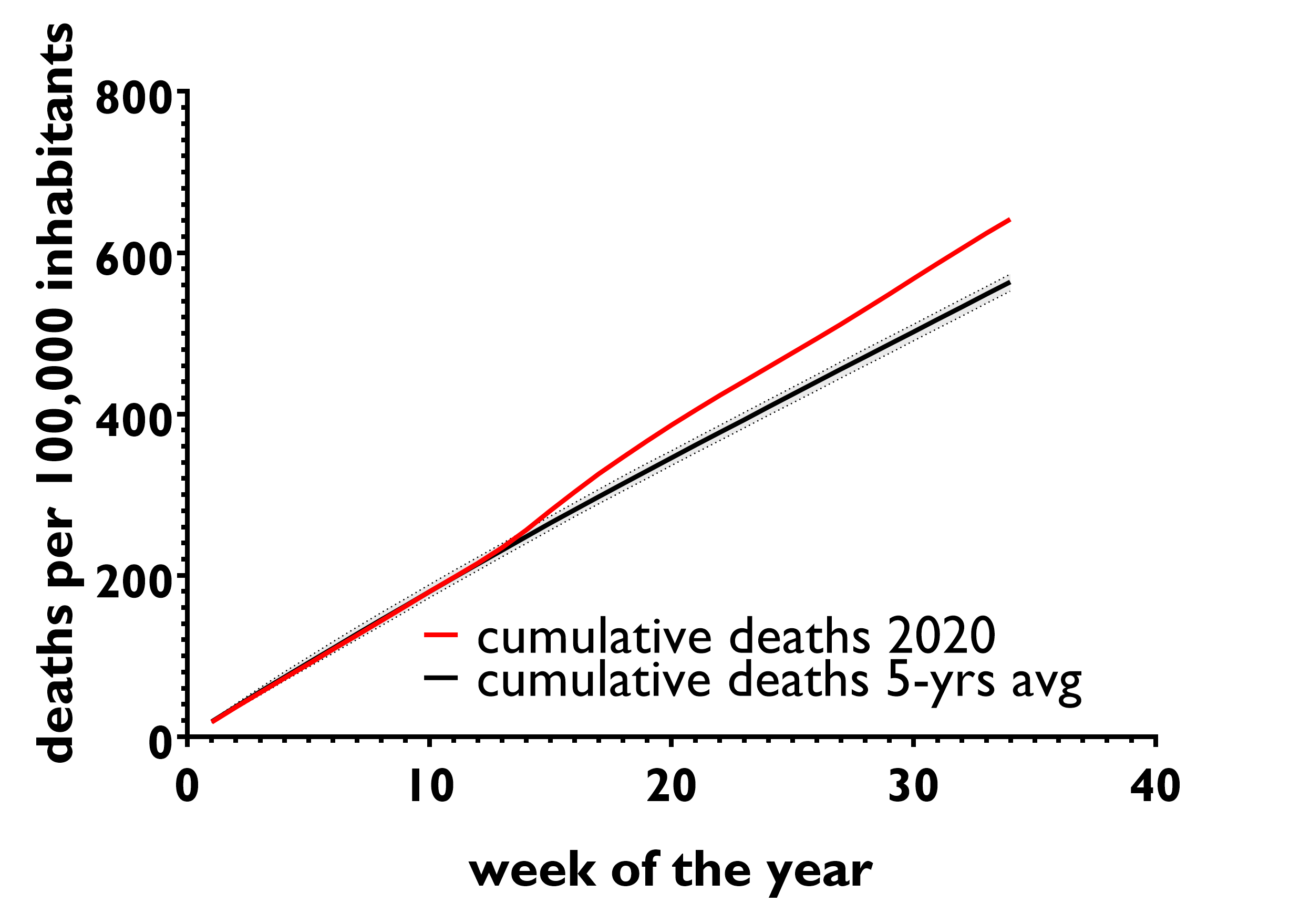

BEHAUPTUNG: U.S. mortalities this year “are not materially different from the previous 5 years”
REVIEW
A recurring claim during the COVID-19 pandemic is that the mortality in 2020 is similar to that of previous years. Such allegations downplay the extent and seriousness of the pandemic by suggesting that COVID-19 has no impact on the overall number of people dying each year. Health Feedback reviewed some of these claims here and here. Another version of this claim circulated in early October 2020 alleging that mortality during the first 34 weeks of 2020 was not different from that of previous years. However, an analysis of the death counts recorded by the U.S. Centers for Disease Control and Prevention (CDC) since 2015 shows that this claim is inaccurate, as we demonstrate below.
The CDC records the number of deaths that occur each week in the U.S.. Health Feedback gathered weekly death counts for every year from 2015 to 2019 and compared the data from weeks one to week 34 of each year with that of 2020.
Comparing death counts that occurred during a given year with the average death counts from previous years highlights periods of time where the mortality is greater than average, known as excess death or excess mortality. It is sometimes difficult to measure the burden of a given event, such as a war or pandemic, in part because of technical limitations like a lack of diagnostic testing. However, evaluating the number of excess deaths provides a direct measure of whether a period of time is abnormally deadly.
First, Health Feedback looked at the cumulative number of deaths in the U.S. from 2015 to 2020 between weeks one to 34 of each year (see Figure 1). The cumulative number of deaths in 2020 is far greater than the cumulative number of deaths of any year from 2015 to 2019, as clearly shown in the figure below. Furthermore, the cumulative number of deaths in 2020 is consistently greater than the number of deaths in previous years, starting on week 13. Week 13 in 2020 began on Sunday 22 March, following an increase in COVID-19 activity in the U.S.

Figure 1: Cumulative number of deaths. Red curve: cumulative number of deaths from all causes from weeks one to week 34 of 2020. Black curve: average cumulative number of deaths from all causes for the years 2015 to 2019. The grey area represents the range of values taken by the individual cumulative number of deaths for each year. Death counts were obtained from the CDC.
Taking into account the size of the U.S. population each year did not alter the result, and also demonstrates that mortality is clearly higher in 2020 compared to the previous five years (see Figure 2).

Figure 2: Cumulative number of deaths normalized to the population size each year. Red curve: cumulative number of deaths from all causes per 100,000 U.S. inhabitants from weeks one to 34 of 2020. Black curve: average cumulative number of deaths from all causes per 100,000 U.S. inhabitants for the years 2015 to 2019. The grey area represents the range of values taken by the individual cumulative number of deaths for each year. Death counts were obtained from the CDC, population size from the U.S. Census Bureau.
Health Feedback also analyzed the number of deaths per week (see Figure 3). This data reveals transient increases or decreases in mortality, providing insight into how mortality rate changes over time. Consistent with the trend in cumulative number of deaths, more people died each week from weeks seven to 34 in 2020 compared to any week during that same interval from 2015 to 2019. These data also show that there are two periods with particularly high mortality, with a first peak at week 15 (early April 2020) and another peak at week 30 (late July 2020).

Figure 3: Weekly number of deaths from all causes. Red curve: Weekly number of deaths from all causes for 2020. Black curve: Average weekly number of deaths from all causes for the years 2015 to 2019. The grey area represents the range of values taken by the individual weekly number of deaths for each year.
In summary, comparing death count records in the U.S. for 2020 and the past five years unambiguously show that mortality in 2020 from weeks one to 34 is higher than the annual mortality in each of the previous five years. From week seven onward, the weekly mortality in 2020 was constantly higher than the weekly mortality in previous years over the same time period. The analysis of excess death, as done here, is an important tool to assess the impact of the COVID-19 pandemic. Indeed, considering there is no evidence indicating that other causes of death have suddenly become more frequent this year compared to previous years, it is highly likely that a large part of those excess deaths are due to COVID-19.
NOTES
This fact check is available at IFCN’s 2020 US Elections FactChat #Chatbot on WhatsApp. Click here, for more.


